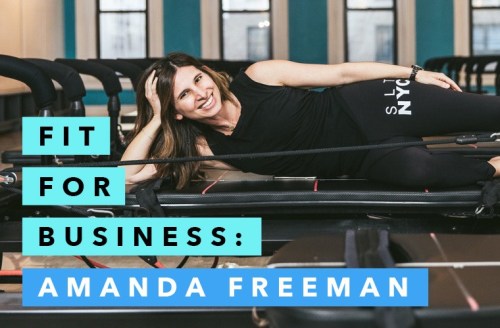Welcome to Fit for Business, a new column from Well+Good’s co-founder and publisher Alexia Brue. Each week, she’ll take you behind-the-scenes with the most successful healthy-living entrepreneurs around the world, so you can learn what inspires them, what challenges them, and what it’s like to work in the (booming) wellness space.
This week she’s sitting down with Amanda Freeman, founder of the “Pilates on crack” boutique fitness studio SLT.
Trying SLT for the first time delivered the same giddiness as I felt when I first learned to drive stick. It was 2011 and Amanda Freeman, a former trend forecaster and wellness media entrepreneur, had just brought the Los Angeles-born Megaformer concept to the New York City fitness scene with a single, buzzy studio in Manhattan. I discovered that I had intercostal muscles…because they were sore for days.
Since opening that first location on 57th Street, Freeman has grown the SLT footprint to 12 studios, with spots in Philadelphia, PA, Hoboken, NJ, Greenwich, CT, and even London, England, among others, set to open in the coming months. (In fact, the studio is slated to open a total of eight new spaces in 2017.)
Thanks to an infusion of capital from North Castle Partners (a private equity firm with an enviable track record in the fitness space—they were early investors in Equinox and last year invested in Barry’s Bootcamp), Freeman is poised to make SLT the dominant brand in the growing Megaformer space.
What’s behind SLT’s enviable growth—and how has Freeman bucked expectations to make it happen? Here, the boutique fitness studio owner shares all.
Where did your inspiration to start SLT come from?
I, like most entrepreneurs, start businesses that I personally want and need. I had become a boutique fitness junkie—loving the idea of a studio that offered the best version of one workout all day long—and had tried every studio in NYC. While I found some I liked, I didn’t love the results that many of the clients (and instructors) were getting in these classes. I was seeking the “Pilates body,” but I was bored by Pilates.
A friend encouraged me to try a class that was only on offer in LA on the Megaformer. It was love at first sight—or sweat. I knew I’d found both the experience and the results I was looking for in a workout. I was running another wellness-focused business called Vital Juice at the time and didn’t need a second job, so I brought the idea of SLT to a few friends in the fitness space and tried to convince them to start it. When those efforts failed, it occurred to me that if I didn’t do this myself, someone else would do it and I’d kick myself for the rest of my life for having not pursued it.
“It’s amazing I was able to recruit the first round of instructors. I found them through a combination of personal referrals and a Craigslist ad.”
What differentiates SLT from everything else out there?
Not to harp on it, but I believe it’s the results (or reSuLTs, as we like to say) and the brand experience that differentiates SLT from other workouts. In the end, a workout is only as good as the results clients achieve from it, and our clients get exactly what they want: lean, toned muscle-definition and increased strength. You feel the change happening instantly and you see it working within a few workouts. And we offer our clients a semi-private, challenging, efficient, and exclusive—but welcoming—experience.
Attracting talent is always a challenge. How did you convince people to join SLT when it was little more than a dream?
To be honest, when I think back on it now, it’s amazing I was able to recruit the first round of instructors. I found them through a combination of personal referrals and a Craigslist ad. Clearly, the former is the best way to do it—but I needed more candidates, so the latter seemed the next best option. I had candidates send resumes, and met with them at my Vital Juice offices. I showed them a video of the Megaformer and some sample moves on my laptop and raved about my personal experience with the workout in LA. I think it was the clear passion I had for the workout that convinced them to sign on for our instructor training. I also believe I benefitted from the timing: In 2011, boutique fitness was certainly taking off, but it wasn’t as competitive a space as it is now.
Additionally, many studios pay their instructors based on the number of clients signed up for their classes. I offered my instructors a flat rate option, too. So they were guaranteed pay regardless of how many people showed up for their classes.
How did you decide whether to bootstrap the business, seek angel investors, or take VC money?
My brother and I put the money into opening the first studio. Fortunately, the upfront investment was low enough that we didn’t need to bring in outside capital—that is what made starting SLT so compelling. And based on financial projections, I knew that if successful, we could fund future studios with cash flow from existing studios.
While I had generous offers from friends and clients to invest at various stages, I enjoyed bootstrapping it for nearly the first five years of operation. It is certainly nice to have only yourself (and your brother) to report to. Based, however, on a desire to accelerate the studio growth and enjoy some liquidity, I made the decision to sell a stake in the business to a strategic private equity shop named North Castle Partners just a few months ago. They are people I enjoy working with and respect a great deal, so it made that decision and shift to having partners easier.
“One of the decisions I’m most proud of was my decision not to put SLT classes on ClassPass. From the moment that business emerged, I didn’t like the proposition they were offering fitness studios.”
Can you tell us about a key decision you made that was a turning point for SLT, but that frankly could have gone either way?
One of the decisions I’m most proud of was my decision not to put SLT classes on ClassPass. From the moment that business emerged—and through all its evolutions—I didn’t like the proposition they were offering fitness studios. While I see the benefits to ClassPass clients, I never understood how they would positively benefit studios in the long run. Nearly every studio has partnered with ClassPass and we haven’t.
Sure, that could have really hurt us, by limiting our reach and exposure, but I have stuck with my principles and my gut instinct and we’ve stayed off of it. We’d likely have increased revenues in the short term had we gone on ClassPass, but at what cost? I believe our clients and brand have benefitted from us staying true to our core clients and our pricing.
Please share a single piece of advice you’d give to another entrepreneur in the wellness space?
Duke basketball coach, Coach K, once said, “Leaders show respect for people by giving them time.” While time is certainly my most precious commodity and I never seem to have enough, I always make time to talk with members of the SLT team and the fitness community. I strongly believe that if I want them to respect me, I must respect them and their desire to be heard.
A business owner’s to-do list is always long. Please share your favorite efficiency hack.
I used to allocate one hour to meetings, now I make most meetings 30 minutes, 45 max.
Everyone wants to know: Does SLT have any open positions?
We are always looking to hire amazing talent. Currently we’re looking for instructors, client services team members, a NYC Studio Manager, and a Director of New Studio Development. Interested? Send your info our way!
Another thing that’s super important when launching a business? Don’t cut corners, according to Drunk Elephant’s Tiffany Masterson. And making bold decisions is always a smart idea.
Sign Up for Our Daily Newsletter
Get all the latest in wellness, trends, food, fitness, beauty, and more delivered right to your inbox.
Got it, you've been added to our email list.














